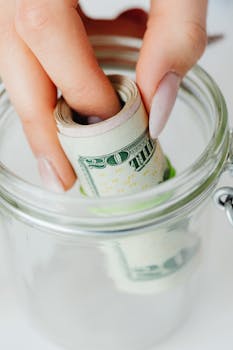Ever wondered why some people handle financial surprise with ease while others scramble to cope? The secret often lies in an overlooked cornerstone: emergency funds. Whether it’s a sudden car breakdown, health issue, or job loss, these savings make all the difference.
In personal finance, having an emergency fund isn’t just practical—it’s transformative. It offers security in unpredictable times and helps avoid the snowball effect of debt when life throws a curveball. Knowing you’re prepared brings vital peace of mind.
If you’re curious about building an emergency fund or want to improve your financial safety net, stick with this guide. We’ll break down the essentials, share relatable examples, and offer actionable tips to help you strengthen your financial future.
Building Your Foundation: Why Emergency Funds Matter
Think of an emergency fund as your personal safety net, designed to catch you during financial falls. This should be a separate account with enough money to cover months’ worth of essential expenses if needed.
It’s like wearing a seatbelt before heading out on a drive—you hope never to need it, but you’ll be grateful it’s there if something happens. The comfort of protection doesn’t slow you down, it enables you to move forward confidently.
- An emergency fund supports you through layoffs, ensuring bills are paid during challenging times.
- It helps tackle surprise home repairs without having to rely on credit or loans that rack up interest.
- Medical emergencies become less financially devastating when you have immediate cash reserves ready.
- Unexpected car repairs or transportation needs won’t derail monthly budgets or cause lasting financial strain.
- Life’s surprises, such as family emergencies or urgent travel, can be handled swiftly and stress-free.
- Reduces the temptation to dip into retirement or long-term investments for immediate needs.
Protecting your future starts with what you save now. These benefits empower better decision-making and reduce anxiety when life gets turbulent, illustrating the importance of a robust emergency fund.
Stories From Everyday Life: Emergency Funds in Action
Picture Linda, who lost her job unexpectedly. Because she’d set aside three months of living expenses, she could focus on her job search instead of panicking about rent or utilities.
Or think about Marcus, whose transmission suddenly failed. Instead of charging expensive repairs to his credit card, he dipped into his emergency fund—avoiding interest and stress, while keeping his financial goals intact.
There’s also Sarah and Jake; when their dog needed urgent surgery, their fund removed the tough choice between debt or their pet’s health. They could focus solely on helping their companion recover.
Across countless situations, having an emergency fund allows for clear-headed responses instead of emotional or risky financial decisions. These stories highlight real-world impacts, proving it’s not about if you’ll need the fund, but when.
Planning Steps: Laying the Groundwork for a Secure Fund
Establishing an emergency fund is simpler when broken into bite-size steps. Here’s a practical path to get your fund started and sustainable, with meaningful comparison points along the way.
- Assess monthly living expenses, including necessities like rent, utilities, groceries, and insurance. This will be your guide for how much to save over time.
- Set a realistic starter goal—many begin with $1,000, but tailor this to what gives you peace of mind. Even small amounts build momentum.
- Open a separate savings account. A different bank or digital account prevents easy spending and keeps your emergency fund distinct from regular savings.
- Automate regular transfers, whether it’s $25 a week or more, so contributions happen without thinking—just like a recurring bill.
- Celebrate progress; compare your fund’s growth every month to remind yourself why you started and how much you’re improving.
- As your income or expenses change, review and adjust your savings goal. Financial stability is a journey best traveled with regular checkpoints.
- Resist the urge to use these funds for anything but genuine emergencies—compare the feeling of security to that of a locked, well-defended castle.
Steady, intentional effort makes the emergency fund grow faster than you’d expect. Every deposit is a step toward long-term stability and resilience.
Comparing Scenarios: With vs. Without an Emergency Fund
Consider two friends, Alex and Ben, both facing a sudden medical bill of $2,000. Alex has an emergency fund; Ben doesn’t. Let’s break down how they respond and recover.
Alex uses part of his stash to pay the bill upfront. He avoids credit card debt and anxiety, knowing he has a backup plan. Ben, meanwhile, must take on high-interest credit debt, adding pressure to his monthly budget.
| Scenario | With Emergency Fund | Without Emergency Fund |
|---|---|---|
| Unexpected Expense | Covered with savings | Resorted to credit/debt |
| Stress Level | Low, thanks to preparation | High, due to uncertainty |
| Financial Impact | Temporary setback, quick recovery | Ongoing payments and interest |
Looking at this table, it’s clear how preparation creates a cushion, while a lack of planning can create cycles of debt and stress that are much harder to escape.
Setting the Right Amount: How Much Is Enough?
Determining your ideal fund size depends on your lifestyle and obligations. For someone with few debts or flexible expenses, three months of essential living costs might suffice. If your household relies on a single income, aim for six months or more.
Think of your emergency fund like packing for a trip—too little, and you’re unprepared; too much, and you’re sacrificing room for things you’d enjoy. Strike the balance by budgeting the basics, adding some cushion, and reviewing whenever circumstances change.
For example, freelancers and gig workers may choose a larger buffer due to income uncertainty, while salaried employees may feel secure with less. Use an online calculator or spreadsheet to run numbers based on your history and expected risks.
The key isn’t to fixate on a number but rather to adapt as your needs evolve. A well-calculated fund will keep you prepared without tying up excessive cash that could serve future financial goals.
Strengthening Your Savings Habits: Making It Stick
- Set recurring calendar reminders to track your emergency fund’s progress each month.
- Review your last year’s unplanned expenses to inform a more accurate savings goal.
- Share your savings goals with a trusted friend or accountability partner for encouragement.
- Seek out savings challenges or apps to gamify your progress and keep yourself motivated.
- Celebrate milestones, no matter how small, with a fun (and affordable) activity.
- Regularly explore savings tools, like high-yield accounts or automatic contribution features.
- Make reviewing and adjusting your savings plan part of your routine, not an afterthought.
Cultivating habits around savings turns emergency preparation from a chore into a habit. Every new routine makes the process more automatic, helping you build security with less effort and more consistency over time.
Over time, what starts as a simple transfer grows into steadfast discipline, reinforcing a culture of planning and proactive money management for you and your household.
Examining the Ripple Effects: What Savings Protect Against
Without emergency funds, minor setbacks can snowball into major crises. Compare what happens when a family doesn’t have savings for repairs: one broken appliance can lead to a utility shutoff, missed work, and compounding bills.
With funds in place, the same scenario is just an inconvenience, not a catastrophe. The ability to absorb shocks—whether medical, mechanical, or personal—protects you from a domino effect of stress and escalating costs.
Alternatively, those living without a savings buffer may be forced to delay necessary expenses or borrow at unfavorable rates. In contrast, prepared savers recover faster, dodge debt, and maintain flexibility to handle whatever happens next.
Conclusion: Embedding Emergency Funds Into Your Financial Blueprint
An emergency fund is more than a rainy-day account—it’s a crucial tool for building stability and resilience in your finances. Preparation now means fewer sleepless nights when surprises arise, empowering you to take smart, measured action.
The peace of mind that comes with knowing you can weather adversity is invaluable. By setting aside funds, you’re not just storing money—you’re investing in your future stability and personal confidence.
Consider emergency savings as non-negotiable, just like insurance or regular health check-ups. It’s an investment in your well-being, your family’s security, and your overall financial goals.
If you haven’t started, it’s never too late to begin, and even small steps count. Focus on steady progress, celebrate your wins, and remember that every dollar saved today makes tomorrow’s surprises more manageable.

